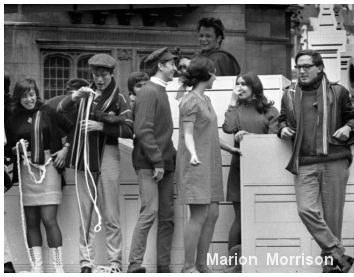 The
British capital was 'swinging'. Football fans were looking forward to the final
of the World Cup. The mini skirt and white lace-up boots were everywhere while
the Cold War between East and West was accepted. The idea of a 'four minute' warning
to doom simply spurred the exuberent, youthful movement for a change. The
British capital was 'swinging'. Football fans were looking forward to the final
of the World Cup. The mini skirt and white lace-up boots were everywhere while
the Cold War between East and West was accepted. The idea of a 'four minute' warning
to doom simply spurred the exuberent, youthful movement for a change.
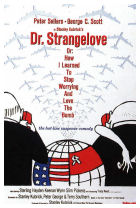 Dr.Strangelove,
or How I Learned to Stop Worrying and Love the Bomb was black comedy
about nuclear war starring the comic genius Peter Sellers in multiple rôles.
It left some of us laughing and others hiding under the bed while it was nominated
with four Academy Awards Dr.Strangelove,
or How I Learned to Stop Worrying and Love the Bomb was black comedy
about nuclear war starring the comic genius Peter Sellers in multiple rôles.
It left some of us laughing and others hiding under the bed while it was nominated
with four Academy Awards
But the reality for many British people a day's work took them home to the small
screen of black and white television on which they viewed the world pouring in
from adventurous film-makers. For me the new media offered a challenging career
and I was lucky to be among the adventurers. With
my colleague Mark Howell and four other graduates I had been around the world
overland - See menu for Around the World - University of Bristol Trans-Continental
Expedition 1960-61 .Then
with hardly time to change clothes I was back in the Middle East and filming with
Tom Stobart, the great north of England film-maker who had shot the first
successful ascent of Mount Everest. 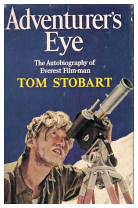 In
the early 1960s Tom teamed-up with Ralph Izzard who, retired from thirty years
with the London Daily Mail was still counted as its most experienced foreign
correspondent. Tom and Ralph were making films for a BBC Adventure a series
devised by the British naturalist David Attenborough, then a young producer. In
the early 1960s Tom teamed-up with Ralph Izzard who, retired from thirty years
with the London Daily Mail was still counted as its most experienced foreign
correspondent. Tom and Ralph were making films for a BBC Adventure a series
devised by the British naturalist David Attenborough, then a young producer. Six
productions in Jordan and Iran with loads of excitement led me back to South America
where I made more films, this time with Mark until the series was halted. It was
a critical time for television as budgets were being directed to ever more ambitious
programmes with colour as a colour channel was due to open a couple of years down
the line. But
while the world was becoming smaller parts were still out of reach and some, including
those dominated by the communist Soviet Russia were not the most welcoming. The
current of Cold War politics had even touched our filming in South America and
once we were reported as spies and requested to 'kindly visit' the local police
chief. So when a call came from Brian Branston a Yorkshireman, author and commissioning
editor of the BBC Travel and Exploration Unit with an offer of 'Destination Danube'
I was openly apprehensive and quietly anxious. Uppermost
in my mind was a new contract ready to sign for two colour films to be tied in
with a book for Andre Deutsch a leading British publisher. The deal meant I would
be travelling for at least two years with my wife Marion in the Andes Mountains
so the horrors of being stuck somewhere behind the Iron Curtain was more excitement
than was good for my digestion. I
can't recall much about the Danube conversation with Brian apart from it being
straightforward with the drift being ' would I like to go to the Danube …
or more seriously would I be prepared to go without any commitment to get a film
…. Or even more seriously without any commitment to a fee '. The nub of the
story was a journey by motor yacht from the Black Sea mouth of the river in Romania
1,920 kms [1,193 miles] up-river to Vienna, the capital of Austria: if successful
it would be the first such journey since the Second World war. Much
of our route would pass through communist or socialist countries with varying
degrees of allegiance to, or mistrust of Soviet Russia and for that matter each
other. Austria was neutral and best known in those times as the setting for Graham
Greene's The Third Man [1949] 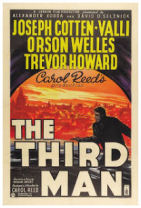 starring
Orson Welles with a story of the appalling post-war black market in penicillin
and since rated among the best films of all time.On a lighter note the story of
the Trapp Family and The Sound of Music[1965] filmed near Salzburg became
an amazing box office success, grossing more than 280m US Dollars. starring
Orson Welles with a story of the appalling post-war black market in penicillin
and since rated among the best films of all time.On a lighter note the story of
the Trapp Family and The Sound of Music[1965] filmed near Salzburg became
an amazing box office success, grossing more than 280m US Dollars. 'Destination
Danube ' was classic mission creep. Brian's enthusiasm for the Danube story was
convincing and I was tempted as knew some of the places. Belgrade in what
was then Yugoslavia is on the right bank of the river and I had been there a couple
of times. 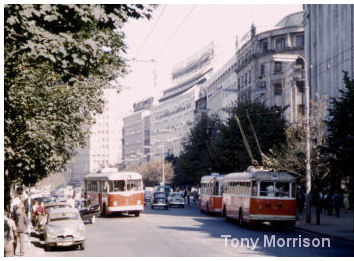 in
1960 I had found Yugoslavia on the verge of change. Out in the country life was
simple and we were driving into the dusk along a warm, dusty unmade roads…
'later as it became darker we passed cart after cart filled with people
moving very slowly away from the villages to their homes.' But new highways
were being built and we would drive a few miles on the concrete of the autoput
and then back to dirt winding through grey limestone mountains. in
1960 I had found Yugoslavia on the verge of change. Out in the country life was
simple and we were driving into the dusk along a warm, dusty unmade roads…
'later as it became darker we passed cart after cart filled with people
moving very slowly away from the villages to their homes.' But new highways
were being built and we would drive a few miles on the concrete of the autoput
and then back to dirt winding through grey limestone mountains. Once
I had followed part Danube's third longest tributary, the Sava from Zagreb [now
capital of Croatia]. 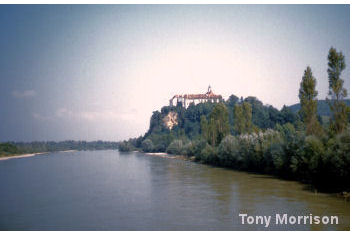 The
Sava enters the Danube at Belgrade. The
Sava enters the Danube at Belgrade. Even
without a visit I felt I knew Budapest as I had shared a laboratory bench at university
with a Hungarian student 'Freedom Fighter' who for simplicity was known to his
fellow British students as 'Fred'. In the 1956 rebellion against the soviet style
government, Fred who was powerfully built, rather like a tank said he had captured
one and driven it through the streets of Budapest. Fred
was one of the 200,000 refugees following the Soviet clampdown. And as for Romania
Tom Stobart's stories of chasing after Kara, a stunning Bessarabian girl were
compelling. Tom crossed Europe twice as borders were closing at the outbreak of
the Second World War and on the second journey when the exit route finally clanged
shut he escaped across the Danube after concealing his camera by wrapping it in
his spare socks stuffed into a bag. So
I was hooked. My speciality was in minimal gear, experience of travelling light,
sleeping anywhere and keeping the exposed film secure. Tom had taught me to use
a small clockwork US made Bell and Howell 16mm camera though my preference was
the
slightly heavier Swiss Bolex H16 - also clockwork. With either system, a couple
of extra lenses and a few rolls of film the weight could be kept below 15 kilos:
at the time a miracle of portability. A
team of nine from Dartmouth College in New Hampshire, USA had just made the trip
downstream by canoe. They had survived and apparently they had been welcomed which
was good news. Their story was published in the National Geographic [July 1965]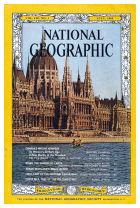 with a magnificent cover picture of the Hungarian neo Baroque Parliament building
overlooking the river. But such details as the hassle of local politics, the inevitable
visas and smoothing the way were avoided.
with a magnificent cover picture of the Hungarian neo Baroque Parliament building
overlooking the river. But such details as the hassle of local politics, the inevitable
visas and smoothing the way were avoided. Looking
back, the story fails to tell the background which as a fact of Cold War life
meant that journalism and especially film-making in Eastern Europe was 'not always
permitted' read: as' hardly ever allowed' and even when agreed, and a Government
'minder' was normally a non-negotiable extra. Brian Branston's caution about up-front
funding was just the beginning. My
tentative and very apprehensive 'OK' led to more background info from Brian and
a short, expenses paid trip to Jersey in the Channel Islands to meet John Marriner
the yacht's owner ' Just to see if I liked the idea'. John
Marriner and September Tide 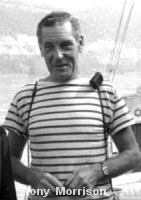 By
1966 John was in the RNVR [Royal Naval Volunteer Reserve] and a member of the
exclusive Royal Thames Yacht Club with its stylish headquarters in Knightsbridge,
London. John was well known among the relatively small post-war British yachting
fraternity and with family investments in Jersey [one of the Channel Islands in
the English Channel] he was wealthy by comparison with many.
By
1966 John was in the RNVR [Royal Naval Volunteer Reserve] and a member of the
exclusive Royal Thames Yacht Club with its stylish headquarters in Knightsbridge,
London. John was well known among the relatively small post-war British yachting
fraternity and with family investments in Jersey [one of the Channel Islands in
the English Channel] he was wealthy by comparison with many.
John's
mother Beryl who was born in Australia was frail and when I arrived at their home
in St Peter close to the airport she was out of sight. His father a mining engineer
had died some years earlier. The family was known for their generosity and on
one occasion they had given two gigs to the Sea Cadet Corps unit on the island.
[gigs = small boats propelled by a variable number of oars].
John was a member of the St. Helier Yacht Club where he is still remembered for
his enterprising adventures. In 1957 when he was in his late forties John bought
Moiena a 55ft [17m] motor yacht and changed the name to September
Tide. The yacht already had a place in history.
One of the heroic 'Little Ships' of Dunkirk As
Moiena the yacht was one of the flotilla of almost 1000
Little Ships that helped evacuate 338,000 soldiers from the port of Dunkirk [Dunkerque
in northern France close to the frontier with Belgium] in
late May and early June 1940 the troops were surrounded by the Nazi German army.
The forced evacuation and the survival of the soldiers, often described as the
Miracle of Dunkirk has a special place in British history | |
September
Tide was John's first yacht and in 1959 he headed north to the Baltic Sea.
At that time it was largely behind the Iron Curtain. Other adventures including
the Danube journey soon followed and are recounted in at least seven of his books.
John used his yacht for the challenge of achieving exceptionlal journeys and he
had very little time to give for simple cruising. He made that clear in Black
Sea and Blue River published in 1968. 'How sad it is that the rich with
their beautiful floating palaces, make so little use of them, Why do they have
yachts at all? Perhaps it is purely a staus -symbol? ' On
reflection it was John's dedication to professional sailing and interest in the
river that broke down the barrier between him as an obviously wealthy yacht owner
and the local people. We met none who were anything but ordinary folk. | Afloat
in Europe 1967- Marriner in the Mediterranean 1967 - Black Sea and
Blue River 1968 - Trebizon and Beyond 1969 - Journey into the Sunrise
1970 - The Shores of The Black Ships 1971 - Sailing to Timbuctoo.1973
And a feature story for the up-market British magazine Country Life - Pepys
at Number Nought, a fascinating glimpse into the international past of Tangier
in Morocco. |
The
Danube The river and the countries
today. But in 1966 the Danube was bordered largely by socialist or communist countries.
If you touch the image you will see
the 1966 divisions in shades of red | 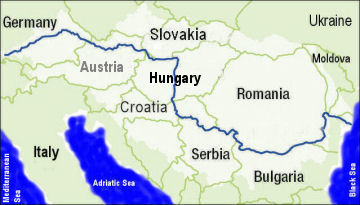 |
Donaueschingen,
a town of about 21,000 in Germany's Black Forest is the accepted source of the
river. The course then runs 2872 kms [1785 miles roughly southeast to the Black
Sea making it the second longest river in Europe. On the way the Danube passes
four capitals and so for centuries it has been seen as a route linking many countries,
some not always happy neighbours. The
Danube has been officially recognised as an International Waterway since the mid
19th Century with an organisation or Commission setting the rules for navigation.
At one time Great Britain and other non-riparian parties were involved but now
only the States bordering the river are members. The current Danube Commission
has its seat in Vienna and issues maps, unifies the river organisation and has
a good website
In 1966 a Danube Commission existed but with Soviet Russian influence meaning
among other conflicting interests that West Germany with the source was excluded
from membership. John Marriner had obtained a set of the excellent Danube Commission
maps so he knew navigation was possible and theoretically if he paid for river
services he could take September Tide all the way to Vienna But
leaving the boat to film towns or people was likely to be a serious no-go. Even
pointing the camera in the wrong direction from the yacht could lead to me, the
crew and even the ship being impounded by unsmiling 'secret' authorities. But
as we chatted in Jersey and later in London,we began to feel more confident. Even
so, a completed film was no more than a dream. And… a rough shooting script?
Forget it. Talk
of the Danube today and many readers turn to Patrick Leigh Fermor whose acclaimed
travel writing has been published by John Murray, possibly the most famous of
British travel publishers. Paddy as he is known to his devotees began a walk across
Europe in 1934, also in Rotterdam but his first book based on the journey was
not ready until 1977. But
we had a very good idea of what we would see as the Danube has always attracted
adventurous writers. Also, in pre-Second World War days paddle steam-ships carried
tourists to many parts of the river so the famous guidebooks such as Nagel and
Guide Bleu had background information. That a yacht journey could be done was
clear from exceptional effort of Negley Farson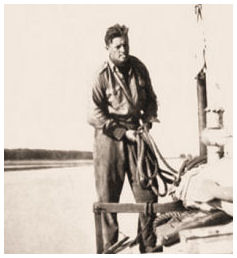 an American journalist who took his 26 foot ketch Flame downriver in the
early 1920s. His wife went along as 'crew'.
an American journalist who took his 26 foot ketch Flame downriver in the
early 1920s. His wife went along as 'crew'. Negley
Farson who was raised by his grandfather, the American Civil War General, James
Negley who was later a Republican in the US Congress, was one of the great foreign
correspondents of his era. Negley Farson was in Russia at the beginning of the
Bolshevik Revolution: he interviewed Mahatma Gandhi in India, he interviewed Adolf
Hitler in Germany and was a friend of Ernest Hemingway. His book Sailing Across
Europe is a Danube classic and was a best-seller. It appeared first in
stories published by the Chicago Daily News. Now the book is free to read or you
can use the audio version on the Internet Archive. Negley
Farson began his journey in Rotterdam, Holland to follow the Rhine upstream and
then cross to the Danube via the Ludwig Canal linking the Rhine and Danube via
the River Main. The Ludwig canal was built between 1836 and 1846 and as Negley
Farson found it was a slow route with many locks. But the link had enormous potential
so in 1921 a deal was reached leading to the construction of a new canal, the
RMD [Rhine Main Danube canal - opened in 1992].
'It was not easy to arrange
…' John
Marriner wrote in his book and indeed it was a cliffhanger. We met at the Royal
Thames Yacht Club to discuss strategy and moved on to meetings at the Bulgarian
Embassy and Romanian Tourist Office [CARPATI] in London. We were open about photography
and film to avoid any doubts later on. The Romanians were totally onside for a
film while the Bulgarians stayed on the fence leaving us unsure of us getting
a green light even as we pulled up the anchor in the Black Sea. The story is in
John's book and the countdown to lifting that anchor was a matter of who would
blink first. August
1966 The
football World Cup final had been won by England in extra time against West Germany
I heard from John that he was heading for Constanta on the Black Sea Coast of
Romania. All was well but as we had anticipated he was unsure of bank transfers
for the crew, river costs and stores. So I began my journey by calling at John's
bank in central London to pick up a large amount of ready cash. It was the era
of British Exchange Controls when holiday-makers were allowed only 50 Pounds sterling
for their travel but with John's business account I was loaded with an eye-watering
wodge. The next day I left by air to Bucharest, the Romanian capital. Constanta
- The Black Sea It
was a late arrival time and I was met by a CARPATI assistant who took me by train
to Constanta where John was waiting with September Tide and his
crew.
 Bobwas
Canadian and was responsible for keeping the ship going. Bobwas
Canadian and was responsible for keeping the ship going. Woody
[right]was from England and as well as deck duties was in charge of the galley
- he was brilliant. Woody had worked in Fortnum and Masons the luxury food shop
in London's Piccadilly. So we fared extremely well even on the long stretches
without a stop. Woody
[right]was from England and as well as deck duties was in charge of the galley
- he was brilliant. Woody had worked in Fortnum and Masons the luxury food shop
in London's Piccadilly. So we fared extremely well even on the long stretches
without a stop.
Once
in Romania John added a fifth member to our Ship's Company. Tutu was a multi-lingual
CARPATI representative who immediately took charge of all arrangements on shore
such as the formalities for entering and leaving ports. When added up at the end
I had three Romanian visas and 9 entry/ exit stamps plus another clutch for Bulgaria
and more for Yugoslavia. 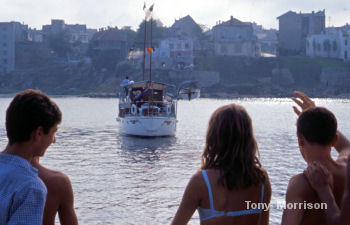 We
left Constanta heading for the small port of Sulina at the mouth of one
of the three main channels or arms of the delta. John planned to head up the 64
km [40 mile long] Sulina Channel as it was the route used by most shiping. We
left Constanta heading for the small port of Sulina at the mouth of one
of the three main channels or arms of the delta. John planned to head up the 64
km [40 mile long] Sulina Channel as it was the route used by most shiping.
The
northern channel or Chilia - 120 kms 74 miles] and the main flow and has not been
artificially straightened. The southern channel St George [Stanful Gheorghe] is
70km [ 43 miles] and at the time was not used. .
The
first highlight was a week spent in the delta and enjoying the the extreme solitude
experienced by the Lipovani ] Lipovan] a group of Old Believers of Russian origin.
We had a copy of Bessarabia and Beyond [1935] aboard so could look back
to even quieter times. Henry Baerlein a Cambridge University educated writer was
an authority on the the ethnic groups and countries of the region.
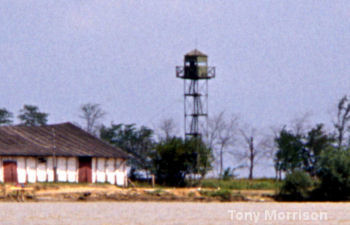 Tom
Stobart's young Bessarabian girlfriend Kara was born in Valcov, [now Vylkove is
in Ukraine] known as the 'Venice of the Delta' from its numerous canals forming
the streets between reed thatched homes. Tom
Stobart's young Bessarabian girlfriend Kara was born in Valcov, [now Vylkove is
in Ukraine] known as the 'Venice of the Delta' from its numerous canals forming
the streets between reed thatched homes.
We
could not get there because it had been part of the USSR since 1940. The border
between Romania and Russia was the Chilia canal where watchtowers were sited on
the sandy bank at numerous and strategic intervals.
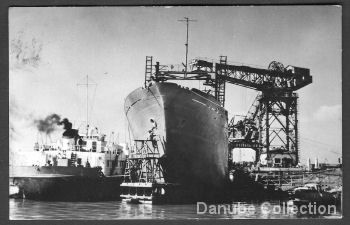 A
postcard home A
postcard home
The
next 900 kms [500 miles were not so colourful read: they were largely dull. At
Galatz [Galati] 80 kms [50 miles] from the mouth I sent a postcard. I think
the best part of the trip is over and we head inland for 500 miles which will
be just about as inspiring as this photograph All
of us on September Tide felt the same. At kilometer 490 [305 miles] we
reached Giurgiu to be welcomed by imposing waterfront arrival building emblazoned
with signs— Long live the Romanian Communist Party and Honour to
our heroic workers It
was in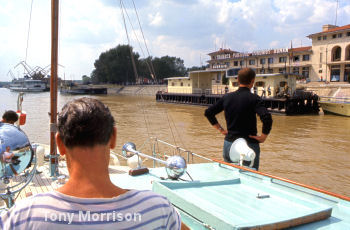 Giurgiu in
1940 where Tom, who had been officially expelled from Romania escaped across the
river to Ruschuk, now Ruse in Bulgaria. Giurgiu in
1940 where Tom, who had been officially expelled from Romania escaped across the
river to Ruschuk, now Ruse in Bulgaria. Like
Tom we crossed to Ruse a city with its fine architecture and grand centre and
the followed the Bulgarian or right bank to Vidin km 785 [488 miles]. We had an
amber light to film so we proceeded with caution and found a very mixed response.
Mostly, and happily it verged on the positive and it's possible that there will
be a short story added here later: provisionally titled Brigitte Bardot, castles,
rosewater and a honey trap Or another could be A hairy night on an Austrian
tug The journey was not so dull after all. Mountains
Ahead 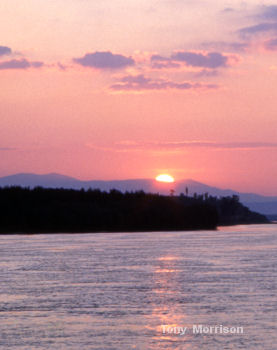 | By
the time we left Vidin my mind was set on a story 953 kms [576 miles] upriver
where the Danube pours through a series of gorges. The Carpathians, Europe's second
longest range and the Balkan mountains are separated by the Danube in a stretch
often known collectively as the Iron Gates. The
true Iron Gate is the lower and least visually impressive of the three and it
is left to two gorges, the lower and upper Cazan [Kazan] meaning 'boliler' or
'cauldron' to create some of the most spectacular river scenery in Europe. Our
starting point was the city of Turnu Severin now using the prefix 'Drobeja' pointing
to its old Roman name. Above Turnu Severin the current was said to be ferocious
and the whole route was a nightmare for a small yacht. Negley
Farson who did the journey downriver with Flame in a hair raising helter
skelter reported 'Flame fought with her rudder like a horse trying to take
over the bit. The engine slowed almost to stopping and then raced as if the stern
were sticking in the air'. |
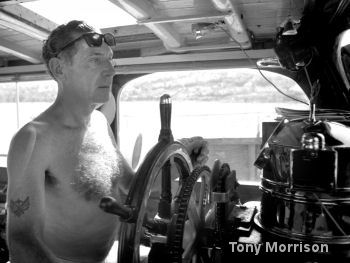 John
Marriner said in his log 'What followed is indescribable. Casting
off from the shore we emerged into the main stream....At one point, as we neared
the narrows I saw her heel outwards from the tug. Christ! I shrieked..., John
Marriner said in his log 'What followed is indescribable. Casting
off from the shore we emerged into the main stream....At one point, as we neared
the narrows I saw her heel outwards from the tug. Christ! I shrieked...,
Just
above Drobeja Turnu Severin a massive dam was being built jointly by Romania and
Yugoslavia [as it was in those times] The dam - now the Iron Gate l was
expected to have a profound effect on the river and the people. Ada
Kaleh an historic fortified island was destined to be drowned, the ancient town
of Orsova would vanish and a magnificently engineered road dating from Roman times
was to be submerged. The turbulent water in the cauldron was due to become a calm,
if spectacular lagoon. All
this seemed a perfect finale. Back in London I viewed the 'rushes' a couple of
times, once with John and once with the BBC before Marion and I left for South
America. I never saw a finished film and suspect that without some sharp political
comments to give it an edge the footage vanished like the island, the Roman road
and the ancient town.
Our
Danube Collection These
Danube stories will never be repeated. Three were lost beneath the water backed
up by the Iron Gate l dam completed in 1972 . Another story, the passage of the
fast flowing river in the Iron Gate went with the building of the dam and its
ship locks. The fifth story covering the Lipoveni set in the beautiful delta has
been 'lost' in the sense that their isolation has been touched by a fast changing
world. The
photographs were shot using Nikon F cameras and lenses. The colour film was Kodak
Ektachrome processed in London by Authenticolour a leading processor and the black
and white was medium grain Kodak Plus X or the more sensitive Tri X film processed
by Roy Reemer, High Holborn London. Sound was recorded on a Uher Report reel to
reel at 7 ½ ips [inch per second on ¼ inch magnetic tape 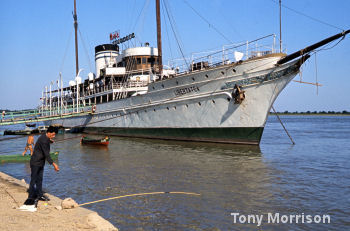 Some
snippets will come with a later instalment - Sulina at kilometer 14 [8 miles]
with its cemetery and some British graves from an earlier era of trade and the
involvemnet with the Danube Commission.. Some
snippets will come with a later instalment - Sulina at kilometer 14 [8 miles]
with its cemetery and some British graves from an earlier era of trade and the
involvemnet with the Danube Commission..
and a working steamboat - the remains of the Roman bridge at Drobeja Turnu Severin
,The luxury yacht Nahlin also at Turnu Severin [ we saw Nahlin as
a very run-down Libertatae and being used as a restaurant. In its heyday
the vessel was one of the finest private yachts in the world and was chartered
in 1936 by the British King Edward Vlll and in the eyes of the British Crown,
his contentious partner the American divorcee Mrs Wallis Simpson. The cruise the
couple made to the Adriatic led to a protocol crisis and ultimately to the abdication
of Edward Vlll. Nahlin
is now back in Britain. The vessel was purchased from the Romanian Government
by a yacht broker in 1998. After transhipment the yacht was restored to its original
luxury condition. Postscript Although
Tutu had taken the sweat out of the formalities up to the Romanian border by Belgrade,
a month after starting I felt I had seen enough. Bob and Woody continued with
John but with serious entry problems in Hungary. Finally they reached Vienna and
September Tide was berthed there over winter. John
Marriner sold September Tide in 1967 and bought a larger ship Morning Watch that
eventually became his home. John
Marriner died in late 1984
The Iron Gate l dam was completed in 1972 and a second dam, Iron Gate ll was commenced
in 1977 and opened in 1984 My
Thanks to those who helped in 1966
To use that old producer's phrase
'once the show was on the road' all went well. Barring a few hiccups we had an
amazing welcome so I must thank the dozens of people especially the officials
who helped me make this collection. Initially a few were stoney-faced and 'official'
but when our journey was explained - usually over a bottle of excellent Russian
vodka or Scotch whiskey any objections melted away. Thank you 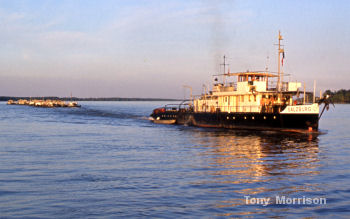 for
a wonderful experience and especially to.... for
a wonderful experience and especially to.... Tutu,
from CARPATI
Archaeologist Prof. A. Radulescu, Constanta
Mila 23 - the entire
village
Danube Pilot Alexander from Orsova
Seppi the Assistant harbour
master at Orsova
Ada Kaleh - to all and I hope the pictures give happy memories
The crew of the Austrian tug Saltzburg, the Captain Josip
his crew and his cook
...and
for help with research in 2013 Jersey
Library, Helen Barette
Australia, Pamela Mawbey Some
books in the Collection Bessarabia
and Beyond - 1935 Henry Baerlein 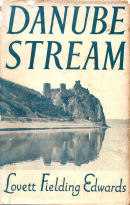 Danube
Stream - 1940 - by Lovett Fielding Edwards, published by Frederick Muller,
London Danube
Stream - 1940 - by Lovett Fielding Edwards, published by Frederick Muller,
London
Lovett
Fielding Edwards lived much of his life in Belgrade. He was an historian and scholar
who spoke many of the languages of the region. He spent four months in the late
1930s travelling by tug, barge and other river-boats down the Danube and this
book is a classic with reference to local spelling. He died in London 1n 1984 The
jacket is a simple 'wartime-cover' and the picture is Golubac castle at the upper
entrance to the Danube gorges Sailing
Across Europe - 1926 - Negley Farson A
Time of Gifts - 1977 Between the Woods and the Water -1986: The
Broken Road - 2013] by Patrick Leigh Fermor who was eighteen when he made
his first journey to the Danube in 1934. PLF was walking across Europe from Holland
to Constantinople [- now Istanbul] and the first book of his trilogy did not appear
until 1977. And of the three, only Between the Woods and the Water looks
at the stretch of the river through the Carpathian mountains. Leigh Fermor returned
to the Danube in 1965 for the American magazine Holiday 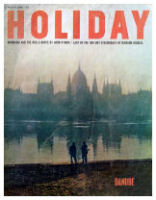 Danube
- Patrick Leigh Fermor, Holiday, [Curtis Publishing] August 1966 and the same
story was re-used in Cornhill a small format literary magazine published by John
Murray, London, Summer 1967. 'Paddy', as PLF is loved by his devotees never covered
the serious issues of the day. Danube
- Patrick Leigh Fermor, Holiday, [Curtis Publishing] August 1966 and the same
story was re-used in Cornhill a small format literary magazine published by John
Murray, London, Summer 1967. 'Paddy', as PLF is loved by his devotees never covered
the serious issues of the day.
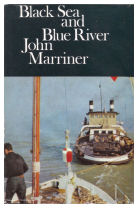 Black
Sea and Blue River - by John Marriner, published by Rupert Hart-Davis 1968
and not to be confused with the much later Blue River Black Sea
by Andrew Eames, Bantam Press 2009 Black
Sea and Blue River - by John Marriner, published by Rupert Hart-Davis 1968
and not to be confused with the much later Blue River Black Sea
by Andrew Eames, Bantam Press 2009
John
Marriner's book with its meticulous detail for navigators reveals his special
knowledge of the Iron Curtain countries and hints of a purpose more daring than
just coiling ropes and polishing binnacles. There is more to this book than the
voyage of September Tide. John's sharp comments, some with unfettered nautical
gusto give a good idea of the challenges including the complex political alignments
of the era. His remarks are often humorous to the point of being Non PC [' Not
Politically Correct']…. after all, the book was the product a mariner in
the 1960s. Here are some of the milder comments. Hangovers
are never my favourite sensation and I felt terribly superior next morning when
we had a rather silent breakfast. It was certainly the case of wardroom breakfast
with newspapers, only unfortunately there were no newspapers to be had
I had to admit that in England as in Romania, mayor's offices were entirely for
business purposes… I
began to get the impression that they were in fact already on the rack, with thumbscrews
around their pretty fingers and arc lights shining in their terrified faces. The
logs from John's Journeys with September Tide and Morning Watch
1958 - 82 were donated to the United Kingdom National Archive in 1997, Reference:
Jersey Archive Service: LD / 06
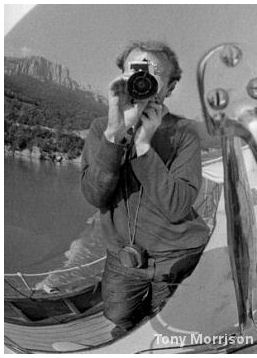 Farewell
to a Danube Island - 1967 Tony Morrison, [right: In the Upper Kazan Gorge]
Geographical Magazine [London] November 1967 Farewell
to a Danube Island - 1967 Tony Morrison, [right: In the Upper Kazan Gorge]
Geographical Magazine [London] November 1967 The
Drowning of Trajan's Road - 1968 Tony Morrison, Illustrated London News 19
- October 1968 Roumanie
Nagel Guide 1965 Roumanian
Journey - 1938 Sacheverell Sitwell Adventurers's
Eye - 1958 Tom Stobart
|